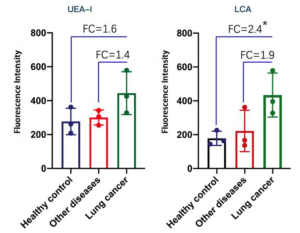A group from Department of Respiratory Medicine, The First Affiliated Hospital of Soochow University, Suzhou, China etc. has reported about lung cancer detection from saliva by using a by immobilized lectin-affinity fluorescent labeling method.
https://www.ncbi.nlm.nih.gov/pmc/articles/PMC9969232/
Quantification of protein glycosylation in human biofluids such as saliva and urine would be an easiest way to identify underlying pathophysiological changes. In this study, lectins (AAL, UEA-I, and LCA) were used for quantitative analysis of salivary protein fucosylation.
Lectins were first covalently bound to amine-reactive beads, while proteins extracted from saliva were labeled with fluorescein tags. The lectins and fluorescently labeled proteins are incubated, and the fucosylated glycoproteins are bound to the lectin beads. The lectin bound glycoproteins were placed in a 96-well plate, and the fluorescence intensity was measure by a plate reader.
As a result, it was found that the fucosylation of salivary glycoproteins significantly upregulated in lung cancer than in healthy controls and other diseases, and lung cancer salivary fucosylation was proportional to the tumor malignancy reflecting the stage of lung cancer.

